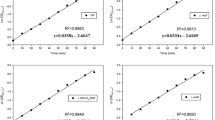Abstract
Mechanisms of recovery from heat injury in Salmonella typhimurium were elucidated. Recovery of the heat-injured S. typhimurium cells in TSB resulted in full recovery after 3 h of incubation at 37°C. The DNA microarray analysis of 30- and 60-min recovering cells resulted in an increase in transcription of 89 and 141 genes, respectively. Among them, 15 genes, with known function, seemed to be somewhat involved in recovery. They encoded proteins involved in branched-chain amino acid (BCAA) transport (livJ, livH), cell envelope integrity (ddg), heat-shock response (cpxP, rrmJ), phage shock protein (pspA), ribosome modulation factor (rmf), virulence (sseB) transcriptional regulation (rpoE, rpoH, rseA, rseB, rseC) and ArcB signal transduction (sixA) and cytoplasmic membrane protein (fxsA). Among them, the effects of BCAA supplementation on recovery from heat injury were studied to confirm the importance of the BCAA transport liv genes during recovery. It was found that supplementation of TSB with 0.1% BCAA resulted in an enhanced recovery of injured cells in comparison to those recovered in TSB without BCAA. Supplementation of BCAA at 0.1% resulted in a cell count increase 4.4-fold greater than that of the control after 1 h incubation. It seems that BCAA promoted the recovery by promoting protein synthesis either directly through their use in translation or indirectly through stimulation of protein synthesis by activation of the Lrp protein.




Similar content being viewed by others
References
Adams MD, Wagner LM, Graddis TJ, Landick R, Antonucci TK, Gibson AL, Oxender DL (1990) Nucleotide sequence and genetic characterization reveal six essential genes for the LIV-I and LS transport systems of Escherichia coli. J Biol Chem 265(20):11436–11443
Blomstrand E, Eliasson J, Karlsson HKR, Kohnke R (2006) Branched-chain amino acids activate key enzymes in protein synthesis after physical exercise. J Nutr 136:269S–273S
Buse MG, Reid SS (1975) Leucine: a possible regulator of protein turnover in muscle. J Clin Invest 56:1250–1261
Busta FF (1976) Practical implications of injured microorganisms in food. J Milk Food Technol 39:138–145
Busta FF (1978) Introduction to injury and repair of microbial cells. Adv App Microbiol 23:195–201
Calvo JM, Matthews RG (1994) The leucine-responsive regulatory protein, a global regulator of metabolism in Escherichia coli. Microbiol Rev 58(3):466–490
Chambliss LS, Narang N, Juneja VK, Harrison MA (2006) Thermal injury and recovery of Salmonella enterica serovar enteritidis in ground chicken with temperature, pH, and sodium chloride as controlling factors. J Food Prot 69(9):2058–2065
Eijkman C (1908) Die Ueberlebungskurve bei Abtötung von Bakterien durch Hitze. Biochem Z 11:12
Garault P, Letort C, Juillard V, Monnet V (2000) Branched-chain amino acid biosynthesis is essential for optimal growth of Streptococcus thermophilus in milk. Appl Environ Biol 66(12):5128–5133
Haney SA, Platko JV, Oxender DL, Calvo JM (1992) Lrp, a leucine-responsive protein, regulates branched-chain amino acid transport genes in Escherichia coli. J Bacteriol 174(1):108–115
Kang DH, Fung DYC (2000) Application of thin agar layer method for recovery of injured Salmonella typhimurium. Int J Food Microbiol 54:127–132
Kobayashi H, Miyamoto T, Hashimoto Y, Kiriki M, Motomatsu A, Honjoh K, Iio M (2004) Identification of factors involved in recovery of heat-injured Salmonella enteritidis. J Food Prot 68(5):932–941
Lawther RP, Calhoun DH, Adams CW, Hauser CA, Gray J, Hatfield GW (1981) Molecular basis of valine resistance in Escherichia coli K-12. Biochemistry 78(2):922–925
Leifson E (1935) New culture media based on sodium desoxycholate for the isolation of intestinal pathogens and for the enumeration of colon bacilli in milk and water. J Pathol Bacteriol 40:581–599. doi:10.1002/path.1700400315
Lynch CJ, Halle B, Fujii H, Vary TC, Wallin R, Damuni Z, Hutson SM (2003) Potential role of leucine metabolism in the leucine-signaling pathway involving mTOR. Am J Physiol Endocrinol Metabol 285:E854–E863
McFarland KA, Dorman CJ (2008) Autoregulated expression of the gene coding for the leucine-responsive protein, Lrp, a global regulator in Salmonella enterica serovar typhimurium. Microbiology 154:2008–2016
Negro M, Giardina S, Marzani B, Marzatico F (2008) Branched-chain amino acid supplementation does not enhance athletic performance but affects muscle recovery and the immune system. J Sports Med Phys Fitness 48(3):347–351
Quay SC, Dick TE, Oxender DL (1977) Role of transport systems in amino acid metabolism: leucine toxicity and the branched-chain amino acid transport systems. J Bacteriol 129(3):1257–1265
Ray B (1979) Methods to detect stressed microorganisms. J Food Prot 42:346–355
Tani TH, Khodursky A, Blumenthal RM, Brown PO, Matthews RG (2002) Adaptation to famine: a family of stationary-phase genes revealed by microarray analysis. PNAS 99(21):13471–13476
Wu VCH (2008) A review of microbial injury and recovery methods in food. Food Microbiol 25:735–744
Conflict of interest
The authors declare no conflict of interest.
Author information
Authors and Affiliations
Corresponding author
Rights and permissions
About this article
Cite this article
Hsu-Ming, W., Naito, K., Kinoshita, Y. et al. Changes in transcription during recovery from heat injury in Salmonella typhimurium and effects of BCAA on recovery. Amino Acids 42, 2059–2066 (2012). https://doi.org/10.1007/s00726-011-0934-y
Received:
Accepted:
Published:
Issue Date:
DOI: https://doi.org/10.1007/s00726-011-0934-y




